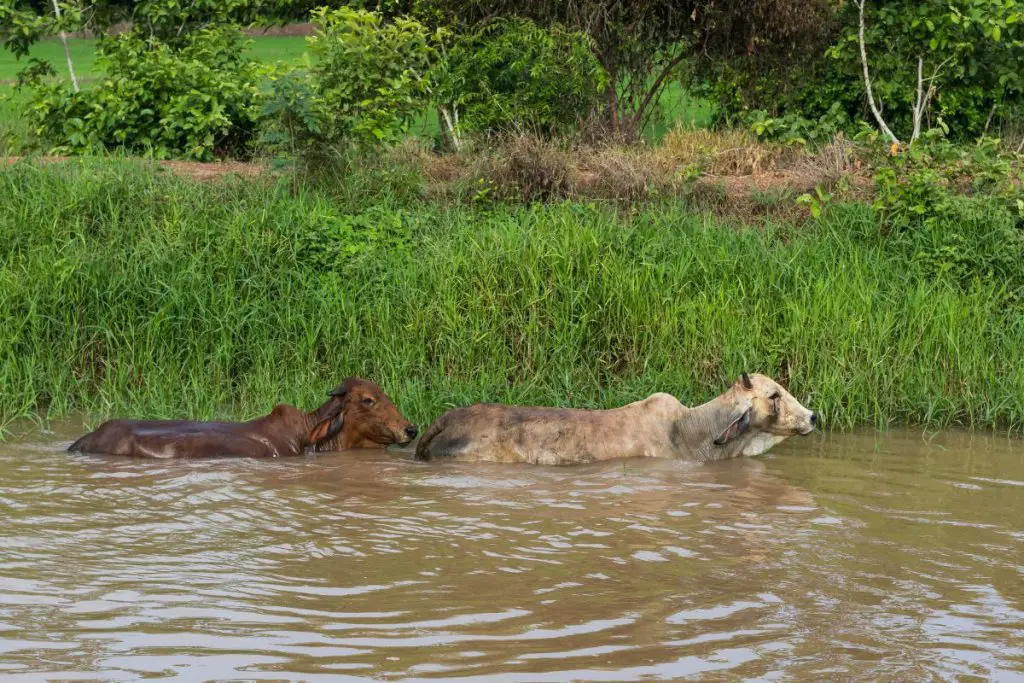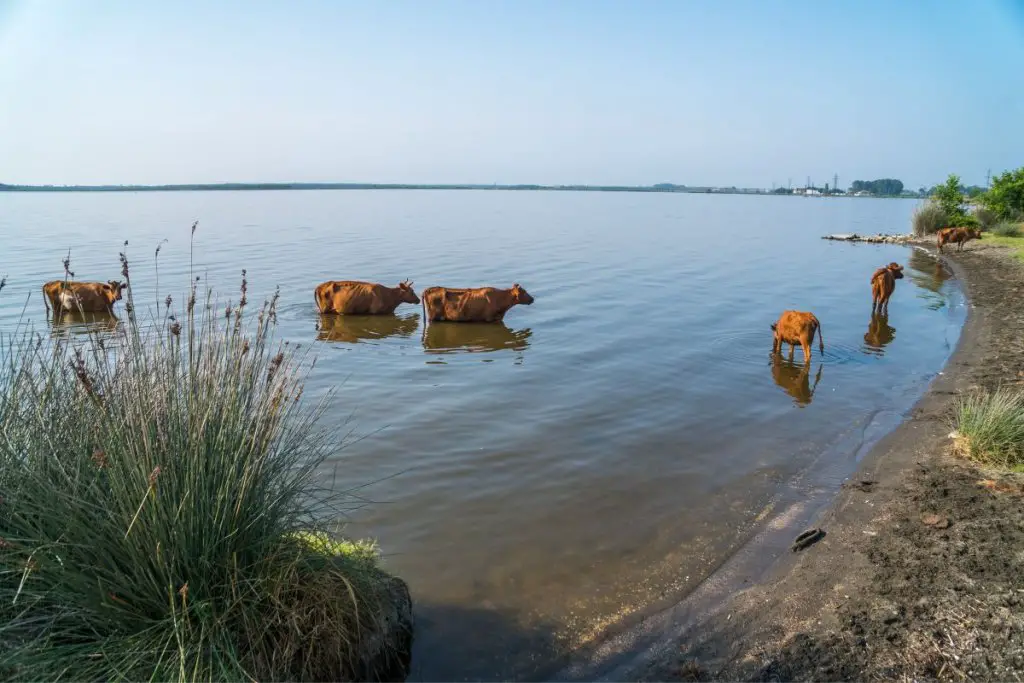Yes, cows can swim, but not for overly long distances. In shallow waters that cover only a part of their legs, cows prefer to move by walking. In deeper waters, cows will propel through the water body by slowly swimming.
It’s incredible all the interesting things cows can do with their bodies! Besides turning grass into milk, cows can do much more with their large, bulky bodies.
Walking and jumping are the main uses for the legs in cattle, but besides these two forms of movement, can cows swim?
Table of Contents
How Do Cows Swim?
Cows swim using the doggie paddle style or breaststroke swimming technique used by humans. This means they swim with their body facing down while paddling with their front legs and frog-kicking the water with their hind legs.

The breaststroke swimming style in cattle resembles a ‘floating run’ in which the cow moves through the water with the head held upright and her body placed in a parallel position to the surface of the water.
What Is It About Cows That Helps Them To Swim?
The following aspects make it easy for cows to swim in water:
- Strong leg muscles that help keep the cow afloat
- Fatty tissues that increase buoyancy
- A large body that increases the surface area to push water
- Hooves that improve traction on the slippery lake or river beds
- Head position (the long neck keeps the head above the water, which helps the cow breathe normally all the time.)
- Prior experience in water (most mammals evolved over thousands of years near natural bodies of water where food was readily available.)
- The body remains parallel to the water surface, which helps reduce water drag.
- Long tail
- Health and fitness
- Stamina
Why Do Cows Swim?
Cows will swim for various reasons, including:
- The need to escape floodwaters
- To get to the udder side—sorry, to cross to the other side of a water body to find greener grazing areas, for example.
- The need for romance and to mate (bulls cross rivers or ponds to reach cows in heat)
- Peer pressure (to follow the rest of the herd)
- The need to teach calves how to swim
- Desire to cool off from the intense heat of the sun
- The need to escape predators like lions
- Human intervention (when a farmer makes them)
Can Cows Swim In Deep Water?
Cows can swim in deep waters, but not for a long time if their head is inside the water. Like humans, the cow must come up for air.
How Fast Do Cows Swim?
There isn’t much evidence to tell how fast a cow can swim. Although they are great swimmers, cows generally swim at slow speeds because of their bulkiness. They can actually run faster.

It’s estimated that most cows can swim 100 meters in about five minutes, which works out to a swimming speed of less than one mile per hour.
However, some believe cows can swim faster than humans at up to 25 miles per hour! But that’s over short distances, and when the cow has a dash of adrenaline caused by sudden stress, leading to the need for flight.
How Far Do Cows Swim?
In gentle waters, cows can easily swim for hundreds of yards. A 100-meter swimming distance would be about 109 yards.
Proof That Cows Can Swim (And How Far)
The following situations have been observed as proof that cows can swim:
- The Maramadi (a cultural cattle race practiced in India in which cattle move through the water. They are taught how to swim in preparation for the intense cattle races.)
- Ranch owners in many areas traditionally swim their cattle to newer pastures across rivers or small lakes.
- A small herd of cattle is believed to have swum about 4 miles across the Core Sound from Cedar Island when Hurricane Dorian hit North Carolina in 2019. National park officials and residents found the cattle at the Cape Lookout National Seashore.
- National Trust cows swim across a 328-foot long channel at the start of the Upper Lough Erne to reach the Inishfendra Island on Crom Estate, where they graze through the summer, before swimming back again in September or October.
- Hundreds of cattle swim through River Tana in Kenya in search of greener pastures.
- The Great Cattle Crossing, in which cows of the Fulani people swim across the Niger River. (Each year, young herdsmen taking cows to greener pastures guide cows across the river to enjoy the glory of winning and the attention of marriageable girls!)
- Cows of the Fula people of Mali swim across the Niger river during six-month transhumance in the rainy season.
What Can I Do To Help My Cows Become Better Swimmers?
There are several reasons you should care about how well your cows can swim.
If you raise your cattle on a family farm with natural or artificial water bodies, you’ll want to be sure your cows can safely swim to the other side.
Here’s what you can do to help them swim across:
- Use a herd leader to lead the other cows into the water
- Use a halter to lead your cow into the water
- Build your cattle’s swimming confidence by regularly encouraging them to get into the water.
- Separate the cows into smaller groups and lead one group across the water body. The other herd of cattle will follow suit to reunite with the others.

Is Swimming Dangerous For Cows?
While cows are good swimmers, it’s not always safe for them to be in the water. There are several reasons and situations when it would be dangerous for them, including:
- Entering an artificial water body like a swimming pool or irrigation ditch that doesn’t have an easy entry or exit point.
- Entering predator-infested waters (crocodiles, anyone?)
- Strong current waters (the cow’s strong legs may be overwhelmed)
- Exhaustion because of swimming over long distances (this can cause the cow to drown)
- Poor water quality may make them ill
- Extreme depths—cows swim underwater, but only over short distances and at shallower depths because they can’t stay under the water for a lot of time.
- Eroding banks or shorelines on large bodies of water, making entry and exit points hard to access.
- Chlorine-treated water kills microorganisms found in the stomachs of cows and causes dehydration when ingested. Since the microorganisms are useful in the digestive system of ruminants, affected cows will have a lower rate of fermentation of food to produce volatile fatty acids.
How Does Swimming Benefit Cows?
Despite the dangers associated with swimming, cows can reap several benefits from the activity. Such benefits include:
- Cooling off in summer
- Avoiding insect bites by floating in gentle waters
- Alleviating stress and pain (cold water is numbing)
- Exercising the body to lose unwanted extra energy
- Toned muscles. Cows use more energy to swim than to walk on dry land. The muscles have to work harder to accomplish the swim.
- Enjoyment (cows do not swim for fun, but they love swimming and like being in the water.)
- Cleaning their bodies
- Saltwater helps remove microorganisms, such as harmful bacteria, from the cow’s skin.
There’s no doubt that cows can instinctively swim for short or long distances when situations call for the activity.
The distances and the durations they manage to swim may not always be phenomenal, but one thing is for sure—cows can swim, and yet some of us can’t!
